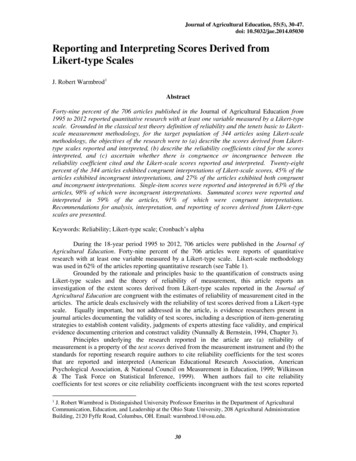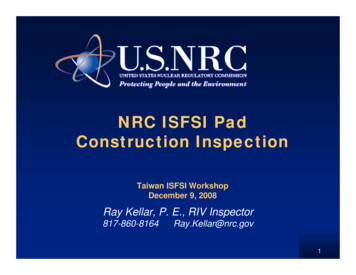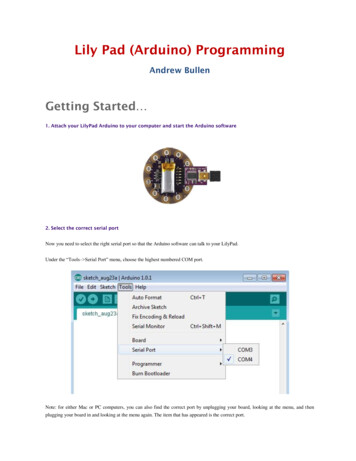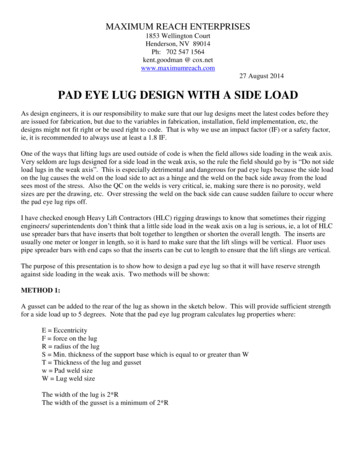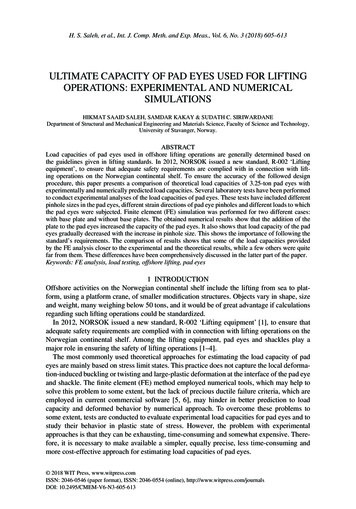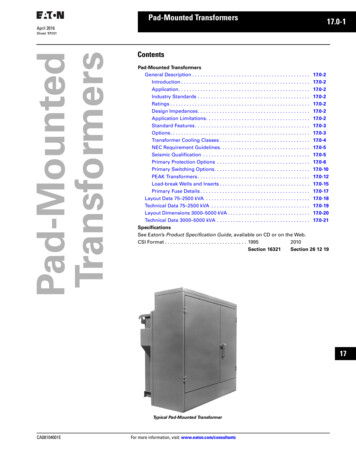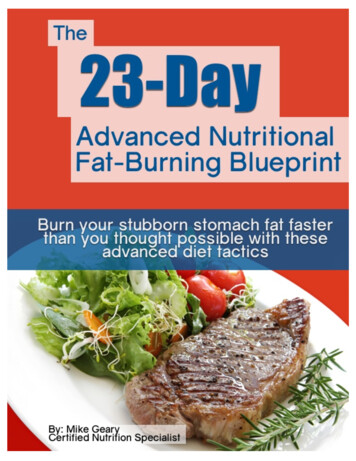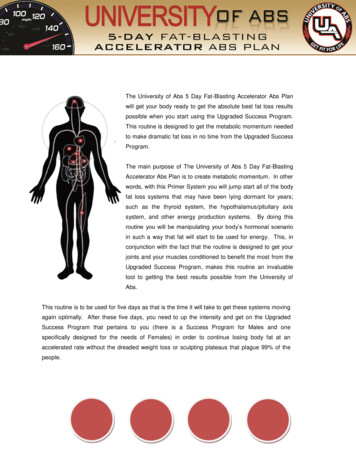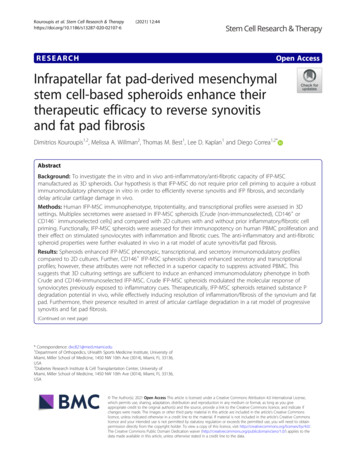
Transcription
Kouroupis et al. Stem Cell Research & 2021) 12:44RESEARCHOpen AccessInfrapatellar fat pad-derived mesenchymalstem cell-based spheroids enhance theirtherapeutic efficacy to reverse synovitisand fat pad fibrosisDimitrios Kouroupis1,2, Melissa A. Willman2, Thomas M. Best1, Lee D. Kaplan1 and Diego Correa1,2*AbstractBackground: To investigate the in vitro and in vivo anti-inflammatory/anti-fibrotic capacity of IFP-MSCmanufactured as 3D spheroids. Our hypothesis is that IFP-MSC do not require prior cell priming to acquire a robustimmunomodulatory phenotype in vitro in order to efficiently reverse synovitis and IFP fibrosis, and secondarilydelay articular cartilage damage in vivo.Methods: Human IFP-MSC immunophenotype, tripotentiality, and transcriptional profiles were assessed in 3Dsettings. Multiplex secretomes were assessed in IFP-MSC spheroids [Crude (non-immunoselected), CD146 orCD146 immunoselected cells] and compared with 2D cultures with and without prior inflammatory/fibrotic cellpriming. Functionally, IFP-MSC spheroids were assessed for their immunopotency on human PBMC proliferation andtheir effect on stimulated synoviocytes with inflammation and fibrotic cues. The anti-inflammatory and anti-fibroticspheroid properties were further evaluated in vivo in a rat model of acute synovitis/fat pad fibrosis.Results: Spheroids enhanced IFP-MSC phenotypic, transcriptional, and secretory immunomodulatory profilescompared to 2D cultures. Further, CD146 IFP-MSC spheroids showed enhanced secretory and transcriptionalprofiles; however, these attributes were not reflected in a superior capacity to suppress activated PBMC. Thissuggests that 3D culturing settings are sufficient to induce an enhanced immunomodulatory phenotype in bothCrude and CD146-immunoselected IFP-MSC. Crude IFP-MSC spheroids modulated the molecular response ofsynoviocytes previously exposed to inflammatory cues. Therapeutically, IFP-MSC spheroids retained substance Pdegradation potential in vivo, while effectively inducing resolution of inflammation/fibrosis of the synovium and fatpad. Furthermore, their presence resulted in arrest of articular cartilage degradation in a rat model of progressivesynovitis and fat pad fibrosis.(Continued on next page)* Correspondence: dxc821@med.miami.edu1Department of Orthopedics, UHealth Sports Medicine Institute, University ofMiami, Miller School of Medicine, 1450 NW 10th Ave (3014), Miami, FL 33136,USA2Diabetes Research Institute & Cell Transplantation Center, University ofMiami, Miller School of Medicine, 1450 NW 10th Ave (3014), Miami, FL 33136,USA The Author(s). 2021 Open Access This article is licensed under a Creative Commons Attribution 4.0 International License,which permits use, sharing, adaptation, distribution and reproduction in any medium or format, as long as you giveappropriate credit to the original author(s) and the source, provide a link to the Creative Commons licence, and indicate ifchanges were made. The images or other third party material in this article are included in the article's Creative Commonslicence, unless indicated otherwise in a credit line to the material. If material is not included in the article's Creative Commonslicence and your intended use is not permitted by statutory regulation or exceeds the permitted use, you will need to obtainpermission directly from the copyright holder. To view a copy of this licence, visit http://creativecommons.org/licenses/by/4.0/.The Creative Commons Public Domain Dedication waiver ) applies to thedata made available in this article, unless otherwise stated in a credit line to the data.
Kouroupis et al. Stem Cell Research & Therapy(2021) 12:44Page 2 of 19(Continued from previous page)Conclusions: 3D spheroids confer IFP-MSC a reproducible and enhanced immunomodulatory effect in vitro andin vivo, circumventing the requirement of non-compliant cell priming or selection before administration andthereby streamlining cell products manufacturing protocols.Keywords: Mesenchymal stem cells (MSC), Infrapatellar fat pad (IFP), CD146 subpopulations, Cell priming, Spheroidcultures, Synovitis, IFP fibrosis, OsteoarthritisBackgroundSynovium and infrapatellar fat pad (IFP) tissues have beenconsidered a single anatomical unit [1], actively participating in the modulation of the knee’s intra-capsular homeostasis [2]. As such, this unit serves as a site of immune cellinfiltration as well as an active source of multiple proinflammatory/pro-fibrotic and articular cartilage catabolicmediators including tumor necrosis factor-alpha (TNF-α),interferon-gamma (IFN-γ), connective tissue growth factor (CTGF), and matrix metalloproteinases (MMPs) [3–9].Clinically, synovial and IFP inflammation and fibrosis areincreasingly recognized with both the onset and progression of joint disease including osteoarthritis (OA) [10–15].Accordingly, targeting this inflammation and fibrosiscould have a potential impact on altering the course of debilitating conditions like OA [16].Given the current challenges of identifying diseasemodifying therapeutic strategies for patients with OA[17], novel alternatives are currently under clinical investigation including cell-based therapy approaches thathave yielded encouraging initial results. For instance,early-stage clinical trials using either heterogeneousadipose-derived stromal vascular fraction cells [18] orexpanded mesenchymal stem/stromal cells (MSC) derived from either umbilical cord [19] or bone marrow[20] have demonstrated clinical superiority when compared with current alternatives such as hyaluronic acidintra-articular placement. Mechanistically, when exposedto an inflammatory environment, MSC exert “medicinalsignaling” activities [21] due to their sensory capacityand secretion of immunomodulatory mediators such asthe tryptophan depleting enzyme indoleamine 2,3-dioxygenase (IDO), interleukin-10 (IL-10), and prostaglandinE2 (PGE2) [22, 23], thereby resulting in strong antiinflammatory effects. However, multiple clinical trialsstill show only moderate or even inconsistent results. Tohelp address this limitation, preclinical studies haveshown that MSC can be “functionalized” in vitro [24] toenhance their therapeutic capacities, while simultaneously reducing the intrinsic phenotypic and functionalvariabilities within cell preparations.MSC can be extracted from multiple sources includingthe knee’s synovium and IFP [25, 26]. IFP-MSC constitute a promising treatment vehicle given their local presence within the joint, ease of harvest during kneearthroscopy, and high proliferation rate in vitro [25, 27].To that end, we have shown that IFP-MSC possess anintrinsic immunomodulatory secretory profile involvingin vitro and in vivo efficient degradation of the nociception and inflammation regulator substance P (SP)through a CD10 (neprilysin/NEP)-dependent pathway.Collectively, this cascade of events leads to reversal ofsynovial and IFP inflammation and fibrosis. Importantly, these specific attributes and functions can be induced or further enhanced in vitro prior to theadministration of the cells. On this basis, we have reported that IFP-MSC exposed to inflammatory cues including TNF-α, IFN-γ, and CTGF (i.e., cell priming/licensing) and/or expanded under regulatory-compliantconditions (e.g., pooled human platelet lysate—hPL)can effectively reinforce the critical CD10 phenotype,which translates into enhanced functional propertiesboth in vitro and in vivo [28–30].On the other hand, we have also recently reported thata similar inflammatory cell priming protocol applied tobone marrow-derived MSC (BM-MSC) enriches thepreparation in CD146 cells, unveiling a subset with innately higher immunomodulatory and secretory capacities compared to their CD146 counterparts [31]. To thebest of our knowledge, a comparable CD146-dependentphenotypic and functional discrimination in IFP-MSChas not been reported to date. Consequently, couplingCD146 with CD10-dependent phenotype-based MSCpurification of heterogeneous preparations could resultin cell products with combined enhanced biologicalfunctions, as previously shown for other definingmarkers such as CD271 [32, 33].MSC possess a remarkable ability to coalesce andassemble in tri-dimensional (3D) structures (i.e., MSCspheroids) that closely recapitulate the in vivo MSCniche by providing spatial cell organization with increased cell-cell interactions. In that context, 3D spheroids provide MSC a stable immunophenotypic profile,with reinforced survival, homing, stemness, differentiation potential, angiogenic, and anti-inflammatory properties [34]. MSC-based spheroids have been applied invarious preclinical models including wound healing,bone and osteochondral defects, and cardiovascular diseases while at the same time demonstrating safety andefficacy (reviewed in [24]).
Kouroupis et al. Stem Cell Research & Therapy(2021) 12:44The current study explores the effects on thephenotypic, transcriptional, secretory, and functionalIFP-MSC profiles when manufactured as 3D spheroidsand following phenotype-based MSC purification.These data further expand our understanding of IFPMSC responses to inflammatory/fibrotic environments. The resulting evidence could be harnessed asa foundation for the design of novel and/or to modifyexisting clinical protocols using IFP-MSC for jointinflammatory disease treatment, with potentially morereproducible clinical outcomes.MethodsCell and animal protocolsIFP-MSC were isolated from IFP tissue obtained fromde-identified, non-arthritic patients (seven males and sixfemales, with an age range between 17 and 60 years old)undergoing elective knee arthroscopy at the LennarFoundation Medical Center–University of Miami andafter provided written informed consent. All procedureswere carried out in accordance with relevant guidelinesand regulations and following a protocol determined bythe University of Miami IRB not as human research(based on the nature of the samples as discarded tissue).IFP tissue ( 20 ml) was mechanically dissected andwashed repeatedly with Dulbecco’s Phosphate BufferedSaline (PBS; Sigma), followed by enzymatic digestionusing 235 U/ml Collagenase I (Worthington Industries,Columbus, OH) diluted in PBS and 1% bovine serum albumin (Sigma) for 2 h at 37 C with agitation. Cell digests were inactivated with complete media [DMEM lowglucose GlutaMAX (ThermoFisher Scientific, Waltham,MA) 10% fetal bovine serum (FBS; VWR, Radnor,PA)], washed and seeded at a density of 1 106 cells/175 cm2 flask in complete media. Medium was changed2 days after cell seeding. Plastic adherent IFP-MSC werecultured at 37 C 5% (v/v) CO2 until 80% confluent (denoted as P0), then passaged at a 1:5 ratio until P3detaching them with TrypLE Select Enzyme 1 (Gibco,ThermoFisher Scientific) and assessing cell viability with0.4% (w/v) Trypan Blue (Invitrogen, Carlsbad, CA).The animal protocol was approved by the InstitutionalAnimal Care and Use Committee (IACUC) of theUniversity of Miami, USA (approval no. 16-008-ad03),and conducted in accordance to the ARRIVE guidelines.Sixteen (#16) 10-week-old Sprague Dawley rats (8 malesand 8 females; mean weight 250 g and 200 g, respectively) were used. The animals were housed to acclimatefor 1 week before the experiment initiation. One rat washoused per cage in a sanitary, ventilated room with controlled temperature, humidity, and under a 12/12-hlight/dark cycle with food and water provided adlibitum.Page 3 of 19Culture of IFP-MSC spheroids and synoviocytesIFP-MSC spheroids were created using gas-permeableculture plates (Miltenyi Biotech, Inc., Auburn, CA).Briefly, 2 105 cells resuspended in DMEM/10%FBS methylcellulose solution (4/1 ratio) were seeded per wellof a 6-well gas-permeable culture plate and cultured for2 days at 37 C and 5% CO2. MSC spheroids were evaluated for phenotypic, secretory, transcriptional, and functional profiles.Synoviocytes (Sciencell, Carlsbad, USA) were culturedusing synoviocyte medium (Sciencell) at 37 C 5% (v/v)CO2 until 80% confluent (denoted as P0), then passagedat a 1:4 ratio until P2 detaching them with TrypLE Select Enzyme 1 (Gibco, ThermoFisher Scientific) andassessing cell viability with 0.4% (w/v) Trypan Blue(Invitrogen, Carlsbad, CA).MSC and synoviocyte primingP3 Crude IFP-MSC (n 5) were seeded in 2D or 3D settings in 6-well plates at a density of 2 105 cells/well incomplete medium. Next day (24 h), cultures wereprimed with TI inflammatory cocktail (15 ng/ml TNFα,10 ng/ml IFNγ) for 48 h or TIC inflammatory/fibroticcocktail (15 ng/ml TNFα, 10 ng/ml IFNγ, 10 ng/mlCTGF) for 72 h. Non-induced and both TI- and TICprimed cohorts were evaluated for secretory and transcriptional profiles. Non-induced and TIC-primed cohorts were evaluated for functional profiles.CD146 surface marker-based magnetic immunoselectionImmunomagnetic cell sorting was performed in P1 CrudeIFP-MSC (n 5). Briefly, 2 106 cells Crude IFP-MSCwere resuspended in 1 PBS with 0.5% bovine serumalbumin (BSA) and 2 mM EDTA and incubated with biotinylated anti-human CD146 (Miltenyi Biotech) at 4 C for20 min with agitation. Invitrogen CELLection Dynabeads Biotin Binder Kit (ThermoFisher Scientific) wasused for magnetic immunoselection resulting in theCD146POS and CD146NEG subpopulations according tothe manufacturer’s instructions. The generated P2CD146POS and P2 CD146NEG subpopulations weredirectly plated and expanded with DMEM/10%FBS until70–80% confluency. All IFP-MSC subpopulations werestored in liquid nitrogen until further experimentation.ImmunophenotypeFlow cytometric analysis was performed on P3 naïve IFP(n 3) MSC. 2.0 105 cells were labeled withfluorochrome-conjugated monoclonal antibodies specificfor CD10, CD44, CD56, CD90 (Biolegend, San Diego,CA), CD146 (Miltenyi Biotech), NG2 (BD Biosciences,San Jose, CA), CXCR4 (Invitrogen), and the corresponding isotype controls. Immunophenotyping marker selection was based on our previous data which associate
Kouroupis et al. Stem Cell Research & Therapy(2021) 12:44their expression levels with distinct immunomodulatorysignatures and functionalities. All samples included aGhost Red Viability Dye (Tonbo Biosciences, San Diego,CA). Data were acquired using a Cytoflex S (BeckmanCoulter, Brea, CA) and analyzed using Kaluza analysissoftware (Beckman Coulter).Immunofluorescence was performed on P3 IFP-MSCspheroids (n 3) in suspension cultures. Briefly, IFPMSC spheroids were fixed in 3.7% paraformaldehyde for1 h at RT, permeabilized with 0.2% Triton-X/gelatin solution for 1 h, and subsequently with 0.5% Triton-X/gelatin solution for 15 min. Fixed/permeabilized IFP-MSCspheroids were incubated with unconjugated primaryantibodies CD10, CD44, CD90 (Abcam, Cambridge,MA), CD146 (Miltenyi Biotech), CXCR4 (Abcam), andNG2 (Invitrogen) overnight at 4 C. Next day, the spheroids were washed 5 with 0.2% Triton-X and incubatedwith secondary antibodies for 1 h. After rinsing 5 with0.2% Triton-X and incubation with DAPI (Invitrogen)for 10 min, images were captured on a Leica TCS SP5confocal microscope using 20 objective and evaluatedwith ImageJ software. All quantifications were performedin at least 5 regions of interest (ROIs) per IFP-MSCspheroid and in total 5 spheroids per IFP-MSC spheroidsubpopulation. Quantitations were performed using theformula: corrected total cell fluorescence (CTGF) integrated density (area of selected cell mean fluorescence of background readings).Quantitative real-time PCR (qPCR)RNA extraction was performed using the RNeasy MiniKit (Qiagen, Frederick, MD) according to the manufacturer’s instructions. Total RNA (1 μg) was used for reverse transcription with SuperScript VILO cDNAsynthesis kit (Invitrogen), and 10 ng of the resultingcDNA was analyzed by qPCR using QuantiFast SYBRGreen qPCR kit (Qiagen) and a StepOne Real-time thermocycler (Applied Biosystems, Foster City, CA). Foreach target, human transcript primers were selectedusing PrimerQuest (Integrated DNA Technologies, SanJose, CA) (Supplementary Table S1). All samples wereanalyzed in triplicate. Mean values were normalized toGAPDH, and expression levels were calculated using the2 ΔΔCt method and represented as the relative foldchange of the primed cohort to the naïve ( 1).A pre-designed 90 gene Taqman-based mesenchymalstem cell qPCR array (Stem Cell Technologies, Supplementary Table S2) was performed (n 3) using 1000 ngcDNA per IFP-MSC sample and processed using StepOne Real-time thermocycler (Applied Biosystems).Data analysis was performed using Stem Cell Technologies qPCR online analysis tool (Stem Cell Technologies).Sample and control Ct values were expressed as 2 ΔΔCt(with 38 cycles cutoff point). The expression levels werePage 4 of 19represented in bar plots ranked by transcript expressionlevels on a log-transformed scale of sample compared tocontrol cohorts. Bar plots were color-coded by the functional class of genes (namely Stemness, MSC, MSCrelated/Angiogenic, Chondrogenic/Osteogenic, Chondrogenic, Osteogenic, Adipogenic). A t test (unpaired,two-tailed test with equal variance) is used in all statistical analysis, and p values were corrected for multiplecomparisons by the Benjamini-Hochberg procedure.Two groups were compared and presented in barplots: sample (spheroids) versus control (2D cultures),and sample (CD146POS spheroids) versus control(Crude spheroids).Trilineage differentiationOsteogenic, chondrogenic, and adipogenic differentiationpotential was evaluated in P3 IFP-MSC spheroids (n 3)similar to previously published protocols [35]. Briefly,MSC spheroids were created using gas-permeable culture plates (Miltenyi Biotech) and methylcellulose andcultured for 2 days at 37 C and 5% CO2 as describedabove. On day 2, IFP-MSC spheroids were subsequentlyinduced towards osteogenesis, adipogenesis, and chondrogenesis by changing the medium to induction mediain the separate gas-permeable culture plate wells. Chondrogenic differentiation was induced for 21 days withserum-free MesenCult-ACF differentiation medium(STEMCELL Technologies Inc., Vancouver, Canada).Harvested spheroids were cryosectioned and 4-μm frozen sections stained with 1% toluidine blue (Sigma) forsemi-quantitative assessment of chondrogenic differentiation. Osteogenic differentiation was induced for 21 dayswith StemPro Osteogenesis differentiation kit (ThermoFisher Scientific). Harvested spheroids were cryosectioned and 4-μm frozen sections stained with 1%Alizarin Red S (Sigma) for semi-quantitative assessmentof mineralization. Adipogenic differentiation wasinduced for 21 days with StemPro Adipogenesis kit(ThermoFisher Scientific). Harvested spheroids werecryosectioned and 4-μm frozen sections stained with0.5% Oil Red (Sigma) for semi-quantitative assessmentof lipid accumulation within the cell cytoplasm. Differentiation status of 3D IFP-MSC spheroids was evaluatedby the expression levels of specific differentiation-relatedtranscripts using qPCR (Supplementary Table S1).Secretome analysisArrays for growth factors (GFs) and inflammatory mediators (RayBio C-Series, RayBiotech, Peachtree Corners,GA) were used to determine secreted levels obtainedfrom P3 Crude 2D IFP-MSC, and P3 Crude and CD146selected IFP-MSC spheroids pre- and post-priming. Foreach population, 1 ml of conditioned media obtainedfrom 2 donors was prepared and used for each assay
Kouroupis et al. Stem Cell Research & Therapy(2021) 12:44following the manufacturer’s instructions. Data shownrepresent 40 s exposure in FluorChem E chemiluminescence imaging system (ProteinSimple, San Jose, CA).Results were generated by quantifying the mean spotpixel density of each array using protein array analyzerplugin using ImageJ software (Fiji/ImageJ, NIH website).The signal intensities were normalized with the background whereas separate signal intensity results represent the average pixel density of two spots pe
1Department of Orthopedics, UHealth Sports Medicine Institute, University of Miami, Miller School of Medicine, 1450 NW 10th Ave (3014), Miami, FL 33136, USA 2Diabetes Research I
